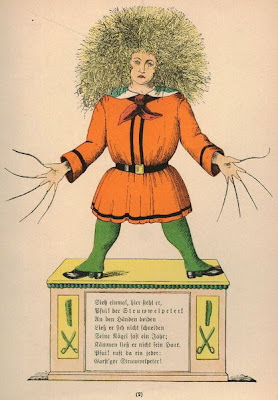Struwwelpeter

After a fortnight I’m back, not with warnings to noose hangers, or moral dilemmas, we’re not even staying in New York today. We are, in a figurative way, going to Germany. I’m in the mood for fairy tales . . .
I grew up in an American home, but some of the customs that my mother, who is of German descent, brought with her to the United States became part of our childhood, especially at Christmas (more on that closer to the that holiday). One bit of the culture that I did not learn about until I was an adult, was Der Struwwelpeter. Loosely translated, it means Slovenly or Shockhaired Peter. He is a boy who doesn’t comb or cut his hair,
 has long dirty nails, and a dirty face.
has long dirty nails, and a dirty face. He’s not so popular.
This filthy boy serves as the introduction and title of children’s tales written by Heinrich Hoffmann, a nineteenth century German psychiatrist. Tales is putting it lightly, these little Geschichte are brutal. One tells, for example, the story of a boy who won’t stop sucking his thumb. He’s warned, but when he persists, someone named the “Great Tall Tailor” comes with giant scissors and cuts them off. Ouch! There are nine of these tales: Little Kaspar who would not eat his soup dies of starvation; Little Hans Look-in-the-Air falls into a canal. You get the drift. My two favorites: The Story of the Inky Boys—three white boys make fun of a black child, and St. Nicholas, takes those white boys and dips them into a big pot of black ink— and the “Dreadful Story of Pauline and the Matches.”
German fairy tales are particular combination of humorous, violent, and creepy at the same time. The main purpose of Jacob and Wilhelm Grimm seemed to be to scare the wits out of every child in Germany. In Rapunzel, a pregnant woman craves broccoli rabe that grows in a witch’s garden. Her husband steals it, has to give up his first born. Somebody gets his eyes put out. In Snow White—queen wants beautiful stepdaughter dead, sends a huntsman out to kill her and carve out her heart. That doesn’t work, so poison apple. Hansel and Grethel—wicked stepmother puts the kids out of the house because there’s no food, they wander in the woods, cannibalism (lots of wicked women in these tales. Hmmmmm.) These are all familiar to most of us. But, seriously? “The Girl With No Hands”? Even the title is gruesome. The story: a beautiful, pure girl doesn’t want to go with the devil (go figure) after her father was tricked into trading her for great riches. At one point her father is compelled by the devil to chop off her hands. Nice.
Apparently the Grimm brothers were dedicated folklorist who collected tales while traveling around Germany. At some point in their research they realized that children loved the stories that they had gathered. I asked my mom if she remembers Struwwelpeter, and she said yes. I asked her if they scared her and her brother, my Uncle Heinz, and she said no, not really. But this is coming from someone who had to go sit in a dark cellar when she was naughty—no wonder the Great Tall Tailor with his giant shears had no effect.
As to Pauline and her matches? Anybody who knows me can guess why I love this story, and why I should read it at least once a year.
All of the tales can be found here.




Comments
I had a marvelous professor once, who taught a whole section of a grad seminar on such tales and collections of these tales, and he did so with a glee nearly unimaginable.
Love, C.